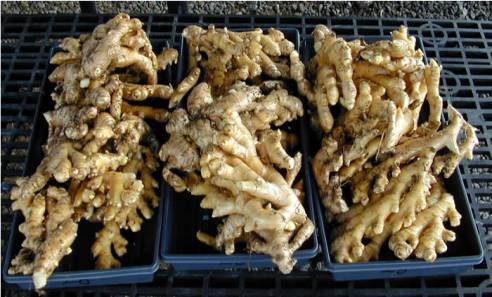|
Origin
Ginger is one of the earliest known oriental spices and is being cultivated in India
both as a fresh vegetable and as a dried spice since time immemorial. Ginger is
obtained from the rhizomes of Zingiber officinale. The ginger family is
a tropical group especially abundant in Indo-Malaysia, consisting of more than 1200
plant species in 53 genera. The genus Zingiber includes about 85 species
of aromatic herbs from East Asia and Tropical Australia. The word ginger is derived
from a Sanskrit word singabera meaning 'shaped like a deer's antlers (horn)'. Ginger
is not known in a wild state and has been cultivated for so long a period in both
China and India that its exact origin is unclear. It is believed to be a native
of Southern Asia. Kerala and Meghalaya are the major ginger growing states in the
country.

Ginger rhizomes
Ginger, reached the West at least two thousand years ago, recorded as a subject
of a Roman tax in the second century after being imported via the Red Sea to Alexandria.
Tariff duties appear in the records of Marseilles in 1228 and in Paris by 1296.
Rosengarten (1969) recorded that ginger was mentioned by the Chinese philosopher
Confucius (551-479 BC). Its medicinal properties are mentioned by Dioscorides (1
century A.D) in his D. Materia Medica. It was introduced to Germany and France in
the ninth century and to England in the tenth century. Ginger is known in England
before the Norman Conquest, as it is commonly found in the 11th century Anglo-Saxon
leech books. Ginger is detailed in a 13th century work, "Physicians of Myddvai,"
a collection of recipes and prescriptions written by a physician, Rhiwallon, and
his three sons, by mandate of Rhys Gryg, prince of South Wales (who died in 1233).
By the 13th and 14th centuries it was familiar to English palates, and next to pepper,
was the most popular spice. Ginger, as a product of the Far East, was indelibly
imprinted on the taste buds of Westerners before potatoes, tomatoes, and corn were
even known to exist by Europeans.
Arabs took it from India to East Africa (13th century). The Portugese Mendoja, introduced
ginger into Mexico soon after the discovery of that country. They in turn introduced
in Jamaica. Since the ginger rhizomes can be easily transported in a living state,
the plant has been introduced to several tropical and sub-tropical countries. Ginger
is now commercially cultivated in nearly every tropical and subtropical countries
in the world with arable land for export crops. The major production is in India,
Jamaica, Nigeria, Sierra Leone, Brazil, China, Japan, Indonesia, Taiwan and Australia.
Jamaica and India produce the best quality ginger. In India, about 70% of the total
ginger production is confined to Kerala. Other states that grow ginger are Assam,
Andhra Pradesh, Himachal Pradesh, West Bengal and Sikkim.
Aroma and flavour
Ginger, being a major spice, has many uses in food, flavouring and medicinal products.
The aroma of ginger is pleasant and spicy and flavour penetrating, pungent and slightly
biting. It is a common ingredient in Asian cooking and it flavours several products
like confectionary, gingerole, curry powders, pickles, several soft drinks and alcoholic
beverages. It is also essential in Western baking like in traditional gingerbreads,
cakes, biscuits etc. It is available fresh and preserved in brine or syrup. Besides
these, ginger oils and oleoresins also have a variety of uses. The essential oil
is used in commercial flavourings.
Medicinal and other use
Ginger is carminative, diaphoretic and spasmolytic. Ginger is truly a world domestic
remedy. Asian cultures have used it for centuries. Experimental data developed by
Chinese scientists verifies the ability of ginger to "strengthen," the stomach while
acting as a mild stomach and intestinal stimulant. It has also been shown to inhibit
vomiting. Animal experiments have also shown analgesic and anti-inflammatory activity.
Even in modern China, while an essential ingredient in almost any meal, it is also
one of the most widely consumed drugs. Both fresh and dried roots are official drugs
of the modern Chinese pharmacopoeia, as is a liquid extract and tincture of ginger.
Ginger is used in dozens of traditional Chinese prescriptions as a "guide drug"
to "mediate" the effects of potentially toxic ingredients. In fact, in modern China,
Ginger is believed to be used in half of all herbal prescriptions. Several of its
pharmaceutical uses are mentioned in Ayurveda. Like the ancient Chinese, in India
the fresh and dried roots were considered distinct medicinal products. Fresh ginger
has been used for cold-induced disease, nausea, asthma, cough, colic, heart palpitation,
swellings, dyspepsia, loss of appetite, and rheumatism. Ginger is as popular a home
remedy in India today, as it was 2,000 years ago. Studies by Japanese researchers
indicate that ginger has a tonic effect on the heart, and may lower blood pressure
by restricting blood flow in peripheral areas of the body. Further studies show
that ginger can lower cholesterol levels by reducing cholesterol absorption in the
blood and liver.
Ginger extracts have been extensively studied for a broad range of biological activities
including antibacterial, anticonvulsant, analgesic, antiulcer, gastric antisecretory,
antitumor, antifungal, antispasmodic, antiallergenic, and other activities. Gingerols
have been shown to be inhibitors of prostaglandin biosynthesis. Other scientific
studies show that gingerol, one of the primary pungent principles of ginger, helps
counter liver toxicity by increasing bile secretion. Ginger has potent anti-microbial
and anti-oxidant (food preservative) qualities as well. A recent study, furthering
ginger's reputation as a stomachic, shows that acetone and methanol extracts of
ginger strongly inhibits gastric ulceration. Several studies published in the last
two decades have confirmed the traditional claims for use as an anti-vomiting or
anti-motion sickness agent.
Ginger is valued the world over, as a culinary herb, condiment, spice, home remedy,
and medicinal agent. It is likely that ginger will be enjoyed and valued for the
next millennium, and new research will undoubtedly reveal new value for this ancient
herb.
|